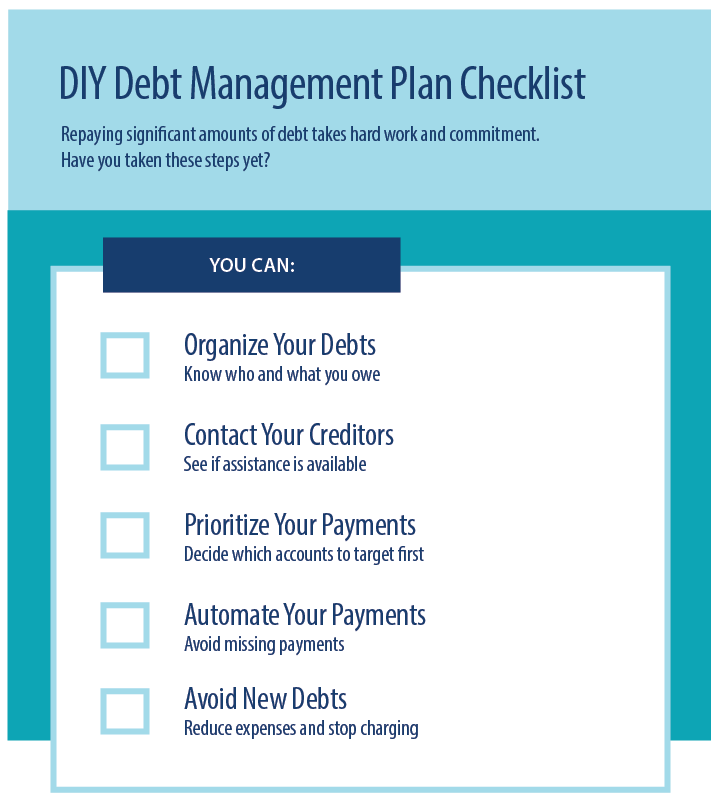Contrasting Debt Debt Consolidation Alternatives: More Discussion Posted Here
Wiki Article
Every Little Thing You Required to Learn About Producing a Tailored Financial Debt Administration Plan
In the world of individual finance, creating a tailored financial obligation management strategy is typically the cornerstone of attaining monetary stability and satisfaction. By thoroughly assessing your current financial responsibilities, setting attainable financial objectives, and crafting a practical budget plan, you lead the way for effective financial obligation repayment approaches. Nonetheless, the journey to economic flexibility is not entirely regarding initial preparation; it likewise requires continuous tracking and adjustments to make sure ongoing progress. As you browse the intricacies of producing a personalized financial obligation monitoring plan, comprehending the details of each action is vital to your monetary success.Analyzing Your Present Financial Obligation Situation
One need to initially carry out an extensive examination of their existing financial obligation commitments before formulating an efficient financial debt administration strategy. Create a comprehensive checklist of each debt, consisting of the complete quantity owed, rate of interest rates, minimal regular monthly payments, and due days.After compiling this details, determine your overall debt-to-income ratio by splitting your month-to-month debt settlements by your regular monthly revenue. This ratio is a key indication of your capacity to handle current financial obligation levels properly. Furthermore, analyze your debt report to determine any type of errors or discrepancies that might be affecting your credit rating. Comprehending these facets of your economic circumstance will certainly lead you in establishing an individualized debt monitoring strategy tailored to your certain needs and objectives.
Setup Financial Goals and Targets

When setting economic objectives, it is necessary to be particular, quantifiable, possible, pertinent, and time-bound (WISE) For instance, you may establish an objective to settle a particular quantity of financial debt within a specific timespan, such as decreasing your charge card balance by $5,000 in the following one year - More Discussion Posted Here. By setting clear targets like this, you can track your progression and remain inspired to attain your financial obligation management objectives
Additionally, think about prioritizing your debts based on aspects such as rates of interest, impressive equilibriums, and settlement terms. By concentrating on high-interest financial debts first, you can conserve cash in the lengthy run and increase your journey towards economic flexibility. Remember, everyone's economic scenario is special, so customize your objectives and targets to fit your private requirements and conditions.
Creating a Realistic Spending Plan
Crafting a well-defined budget is a basic action in efficient financial debt management and economic planning. A realistic budget plan offers as a roadmap for your economic wellness, helping you track your earnings, expenditures, and financial obligation repayments. To develop a useful budget plan, start by noting all your sources of revenue.When setting budget restrictions, be sincere with on your own concerning your investing practices and monetary responsibilities. Allocate a section of your earnings towards paying off financial debt while ensuring you have some funds for savings and emergency situations. Regularly evaluation and adjust your budget as required to remain on track with your economic objectives and financial debt settlement plan. By sticking to a realistic budget, you can efficiently manage your financial debt and job in the direction of an extra safe monetary future.
Discovering Financial Debt Payment Methods
After establishing a sensible budget plan, the following important action in efficient financial debt monitoring is to discover different financial debt repayment methods. One common method is the snowball technique, where you concentrate on settling the smallest financial obligations initially while making minimum settlements on larger financial debts. This approach can aid construct momentum as you see smaller sized financial obligations being gotten rid of, giving motivation to take on bigger ones.An additional technique is the avalanche go to this web-site approach, which entails focusing on debts with the highest possible rate of interest. By targeting high-interest financial obligations first, you can decrease the total amount you pay in interest gradually. This approach may be much more cost-efficient over time, even though it could take longer to see specific debts totally repaid.
Financial debt loan consolidation is an additional option review where you incorporate numerous debts into a single lending with a reduced rates of interest. This can streamline your payment procedure and potentially reduce the total interest paid. Nonetheless, it's important to carefully consider the terms and costs connected with combination to ensure it's the appropriate choice for your monetary circumstance.
Surveillance and Readjusting Your Plan

Readjusting your strategy might involve reallocating funds to deal with high-interest debts initially, bargaining with financial institutions for lower interest you can find out more prices or much better payment terms, or discovering additional revenue sources to expedite debt payment. As your financial situation progresses, your financial debt administration strategy must adapt appropriately to remain efficient. By remaining flexible and aggressive in tracking and changing your plan, you can maximize your initiatives in the direction of settling your debts effectively and attaining your financial goals.
Final Thought
In final thought, developing an individualized financial obligation management plan includes assessing present financial debt, setting monetary objectives, creating a realistic spending plan, checking out repayment strategies, and surveillance and changing the plan as needed. By following these steps, people can take control of their monetary situation and work in the direction of becoming debt-free. It is necessary to stay disciplined and committed to the strategy in order to achieve long-lasting economic security.
One must initially conduct a comprehensive examination of their current financial debt responsibilities prior to developing a reliable financial obligation administration strategy.After establishing a sensible budget, the next crucial action in efficient financial obligation administration is to check out numerous financial obligation payment methods - More Discussion Posted Here.To successfully manage your debt, constant surveillance and adjustment of your financial debt management strategy are important parts for long-lasting economic security.Readjusting your plan may involve reapportioning funds to deal with high-interest debts first, negotiating with lenders for lower interest prices or far better repayment terms, or checking out added earnings resources to quicken financial obligation settlement.In final thought, developing a tailored debt monitoring strategy entails assessing current financial debt, setting monetary goals, creating a realistic budget plan, checking out settlement approaches, and tracking and changing the plan as needed
Report this wiki page